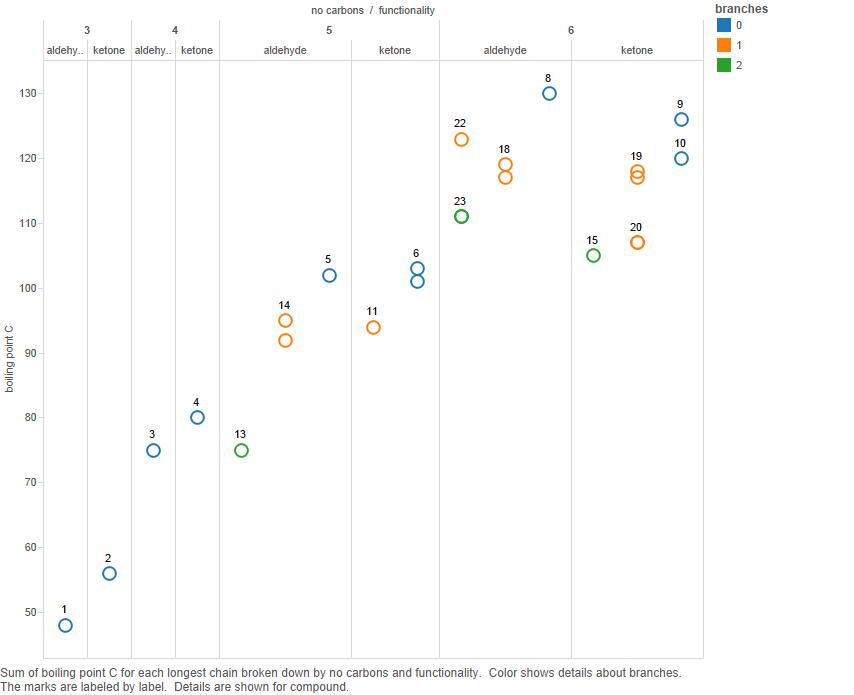Both aldehydes and ketones have a carbonyl group, but since the carbonyl group of ketone is between alkyl groups, wouldn't it be more difficult for it to form hydrogen bonds than aldehydes? Why then, do ketones have a higher boiling point than aldehydes?
-
$\begingroup$ I'm not sure invoking hydrogen bonding is helpful, as simple ketones/aldehydes have very little enol character and therefore their physical properties should be determined by the keto forms. $\endgroup$– Nicolau Saker NetoCommented Nov 18, 2013 at 23:57
-
2$\begingroup$ Have a look at the comments to the answer of Rauru Ferro. He has posted a link that shows data which imply that it is not generally true that ketones have a higher boiling point than aldehydes - in fact they seem to be very similar and which one is higher changes within the homologous series. Maybe the explanations given in the comments already give you the explanation you seek. If they still don't answer your question you could specify the points you want to know more about. $\endgroup$– PhilippCommented Nov 21, 2013 at 0:19
-
$\begingroup$ To follow up on Neto's answer more explicitly: Due to the nature of the sp2 hybridized carbon, aldehydes have very little hydrogen bonding character in the non-enol form. $\endgroup$– LighthartCommented Feb 20, 2014 at 0:20
3 Answers
It isn't that good a generalization: always look at the data first.
Here is a table of most of the aldehydes and ketones with 6 or fewer carbons (the labels are used in the chart later):

Now plot this on a chart:

Branches is the number of branches in the carbon chain.
Note that while for 3 and 4 carbons the ketones do have higher boiling points, it is not clear this is true for 5 carbon compounds and certainly not true for 6-carbon ones.
So, I'd argue the pattern of boiling points is complicated and there is no simple pattern that needs to be explained.
Amongst aldehydes and ketones, ketones have higher boiling point. This is due to the presence of two electron donating alkyl groups around the $\ce{C=O}$ group which makes them more polar.
For example: the boiling point of $\ce{CH3-CHO}$ is 322 K and dipole moment is 2.52 D.
Boiling point of $\ce{CH3-CO-CH3}$ is 329 K and dipole moment is 2.88D
Dipole moment of $\ce{CH3-CO-CH3}$ is greater than of $\ce{CH3-CHO}$. This because there are two electron donating $\ce{CH3}$ groups around $\ce{C=O}$ bond whereas there is only one $\ce{CH3}$ group around $\ce{C=O}$ in $\ce{CH3CHO}$.
As dipole moment is greater so it is more polar and hence has higher boiling point.
-
6$\begingroup$ Just a minor point: the comparison between acetaldehyde and acetone is not entirely fair, since acetone is also a heavier molecule, so its comparatively greater London dispersion forces will also come into play (albeit with a lesser degree of significance than difference in dipole moments). I think a better comparison would be between acetone and propanal, since that would be comparing molecules of the same size. Still, as the document Rauru Ferro linked to notes, the b.p. trend isn't entirely consistent. $\endgroup$– Greg E.Commented Dec 21, 2013 at 11:57
-
2$\begingroup$ Considering that the carbon atom is positively polarised, why don't the electron donating groups reduce this polarization rather than increasing the polarization? $\endgroup$– BaluCommented Mar 24, 2022 at 7:23
-
$\begingroup$ How would electron donating groups increase polarity, this makes no sense. $\endgroup$ Commented Mar 1 at 8:18
For ketones and aldehydes of similar molecular mass, ketones have higher boiling point due to the fact that its carbonyl group is more polarized than in aldehydes. So, interactions between molecules of ketones is stronger than between molecules of aldehydes, and that gives a higher boiling point.
-
$\begingroup$ Could you explain why the carbonyl group is more polarized in ketones than it is in aldehydes? Or could you provide a reference for this? $\endgroup$– PhilippCommented Nov 20, 2013 at 0:19
-
$\begingroup$ As I remember from my Organic chemistry basement, the difference between ketones and aldehydes is based in the electronic distribution between carbon and oxygen. This distribution is more accused in ketones than in aldehydes, because in aldehydes, the hydrogen bounded the carbon of the carbonyl group give electronic density to the carbon (because hydrogen is less electronegative than carbon). $\endgroup$– RFGCommented Nov 20, 2013 at 8:43
-
1$\begingroup$ Hmm, but shouldn't there also be hyperconjugation between the additional alkyl group and the carbonyl group's $\pi$ orbital which would also give electron density to the carbonyl carbon? Is this effect that much weaker than the small difference in electronegativities between carbon and hydrogen that it leads to a significantly higher polarization of the carbonyl group? $\endgroup$– PhilippCommented Nov 20, 2013 at 10:22
-
1$\begingroup$ I've found this document: google.es/…, where in pages 411-412 describes two canonical forms neutral and polarized, where the polarized form have a minor contribution. May be this could explain the little differences between boiling points (page 419). $\endgroup$– RFGCommented Nov 20, 2013 at 14:32
-
1$\begingroup$ Your linked document seems to suggest that the assumption this question is based upon is wrong since there are cases where the boiling point of the aldehyde is (slightly) higher than that of the corresponding ketone. The fact that the boiling points are quite similar might mean that the effects I described in my previous comment are nearly equal in strength. $\endgroup$– PhilippCommented Nov 21, 2013 at 0:13
